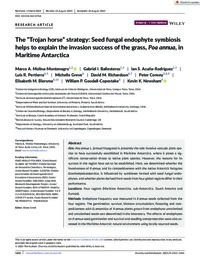Mostrar el registro sencillo de la publicación
The "Trojan horse" strategy: seed fungal endophyte symbiosis helps to explain the invasion success of the grass, Poa annua, in maritime Antarctica
| dc.contributor.author | Molina-Montenegro, Marco A. | |
| dc.contributor.author | Ballesteros, Gabriel I. | |
| dc.contributor.author | Acuña-Rodríguez, Ian S | |
| dc.contributor.author | Pertierra, Luis R. | |
| dc.contributor.author | Greve, Michelle | |
| dc.contributor.author | Richardson, David M. | |
| dc.contributor.author | Convey, Peter | |
| dc.contributor.author | Biersma, Elisabeth M. | |
| dc.contributor.author | Goodall-Copestake, William P | |
| dc.contributor.author | Newsham, Kevin K. | |
| dc.date.accessioned | 2023-10-30T18:40:12Z | |
| dc.date.available | 2023-10-30T18:40:12Z | |
| dc.date.issued | 2023 | |
| dc.identifier.uri | http://repositorio.ucm.cl/handle/ucm/5072 | |
| dc.description.abstract | Aim: Poa annua L. (annual bluegrass) is presently the sole invasive vascular plant spe-cies to have successfully established in Maritime Antarctica, where it poses a sig-nificant conservation threat to native plant species. However, the reasons for its success in the region have yet to be established. Here, we determined whether the invasiveness of P. annua, and its competitiveness with the native Antarctic hairgrass Deschampsia antarctica, is influenced by symbioses formed with seed fungal endo-phytes, and whether plants derived from seeds from four global regions differ in their performance.Locations: Four regions (Maritime Antarctica, sub-Antarctica, South America and Europe).Methods: Endophyte frequency was measured in P. annua seeds collected from the four regions. The germination, survival, biomass accumulation, flowering and com-petitiveness with D. antarctica of P. annua plants grown from endophyte-uncolonised and uncolonised seeds was determined in the laboratory. The effects of endophytes on P. annua seed germination and survival and seedling osmoprotection were also as-sessed in the Maritime Antarctic natural environment using locally-sourced seeds. Results: Endophytes were at least twice as frequent in seeds from Maritime Antarctica than in those from other regions. A higher proportion of endophyte-colonized seeds germinated and survived than did uncolonised seeds, but only when they originated from Maritime Antarctica. Seed endophytes increased the competitiveness of P. annuawith D. antarctica, but only for plants grown from Maritime Antarctic seeds. In the field, endophyte-colonized seeds from Maritime Antarctica germinated and survived more frequently than uncolonised seeds, and osmoprotection was higher in seedlings grown from colonized seed.Main Conclusions: The findings indicate beneficial effects of seed endophytes on invasion- related traits of P. annua, such as survival, germination success and flowering. Together with vegetative and reproductive traits facilitating the colonization process, the seed-fungal endophyte symbiosis can be invoked as an important factor explain-ing the invasiveness of P. annua in Maritime Antarctica. | es_CL |
| dc.language.iso | en | es_CL |
| dc.rights | Atribución-NoComercial-SinDerivadas 3.0 Chile | * |
| dc.rights.uri | http://creativecommons.org/licenses/by-nc-nd/3.0/cl/ | * |
| dc.source | Diversity and Distributions, 29(11), 1432-1444 | es_CL |
| dc.subject | Annual bluegrass (Poa annua) | es_CL |
| dc.subject | Antarctic hairgrass (Deschampsia antarctica) | es_CL |
| dc.subject | Biological invasion | es_CL |
| dc.subject | Cladosporium | es_CL |
| dc.subject | King George Island | es_CL |
| dc.subject | Maritime Antarctica | es_CL |
| dc.subject | Seed fungal endophytes | es_CL |
| dc.subject | Symbiosis | es_CL |
| dc.title | The "Trojan horse" strategy: seed fungal endophyte symbiosis helps to explain the invasion success of the grass, Poa annua, in maritime Antarctica | es_CL |
| dc.type | Article | es_CL |
| dc.ucm.indexacion | Scopus | es_CL |
| dc.ucm.indexacion | Isi | es_CL |
| dc.ucm.uri | onlinelibrary.wiley.com/doi/10.1111/ddi.13768 | es_CL |
| dc.ucm.doi | doi.org/10.1111/ddi.13768 | es_CL |



